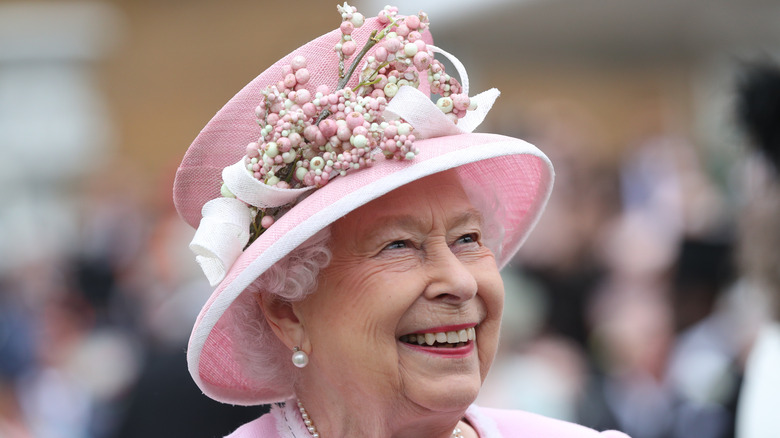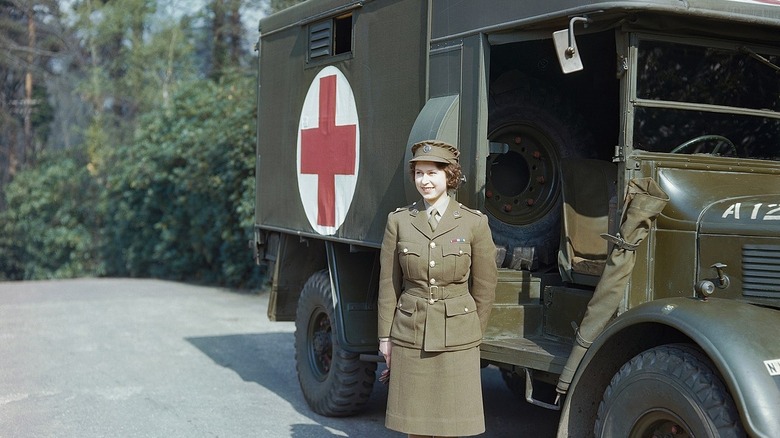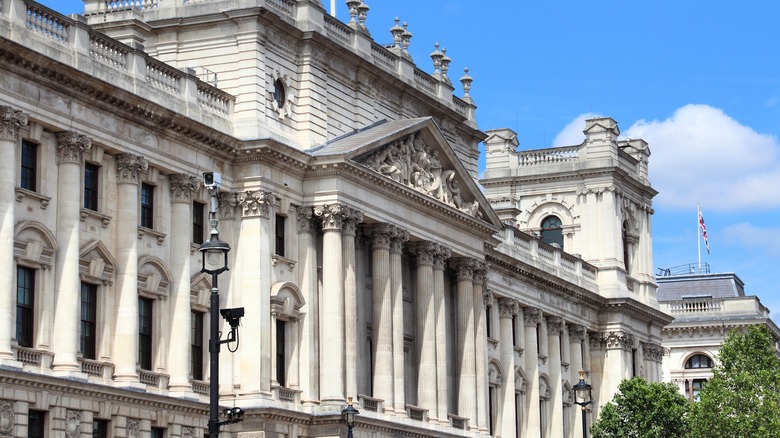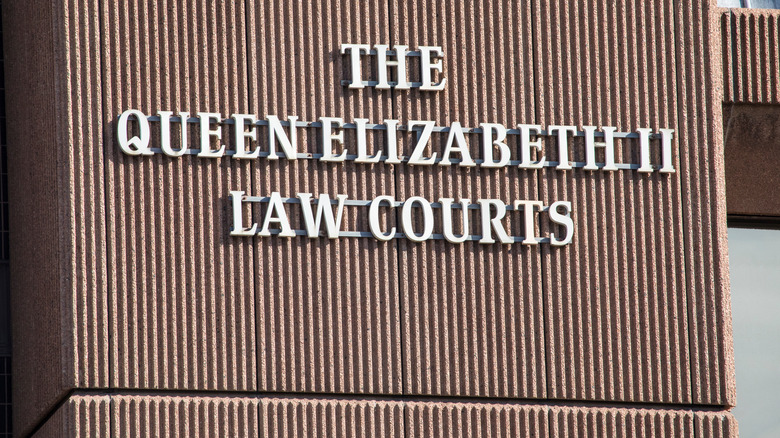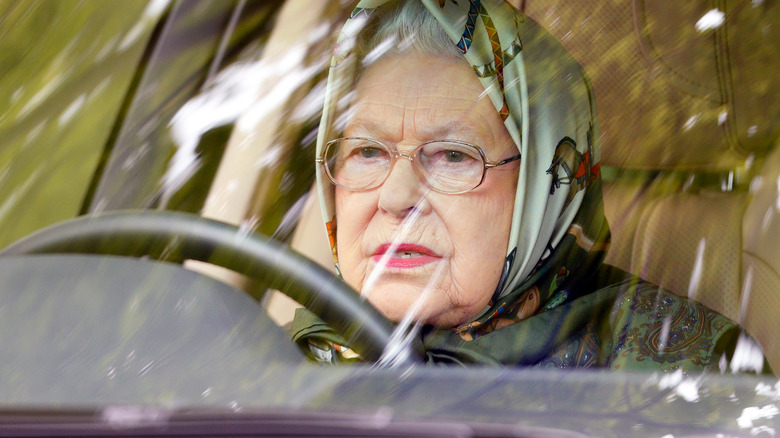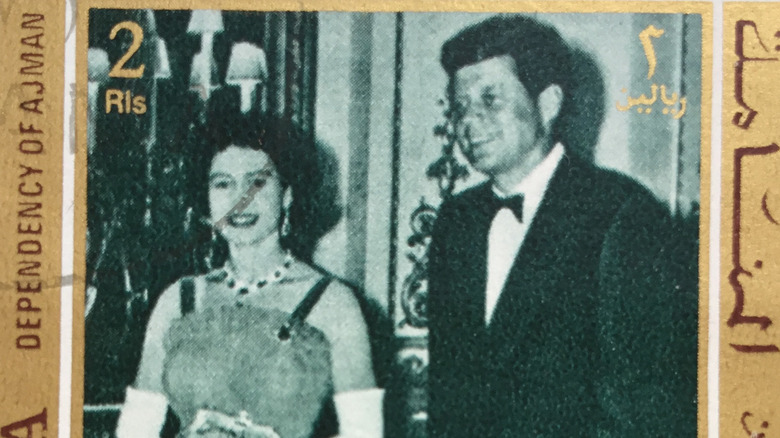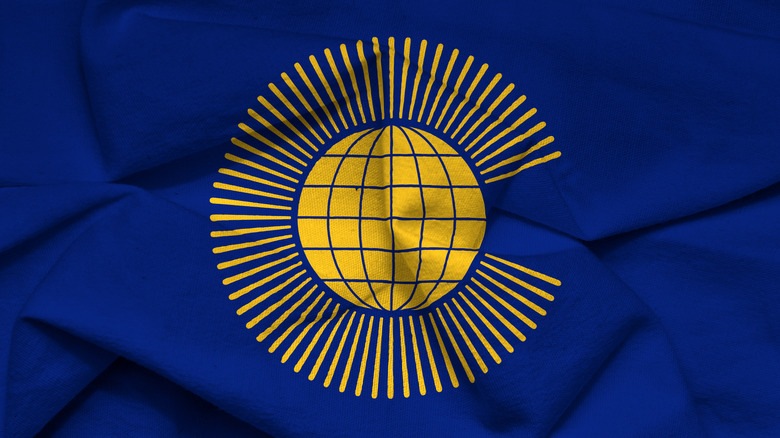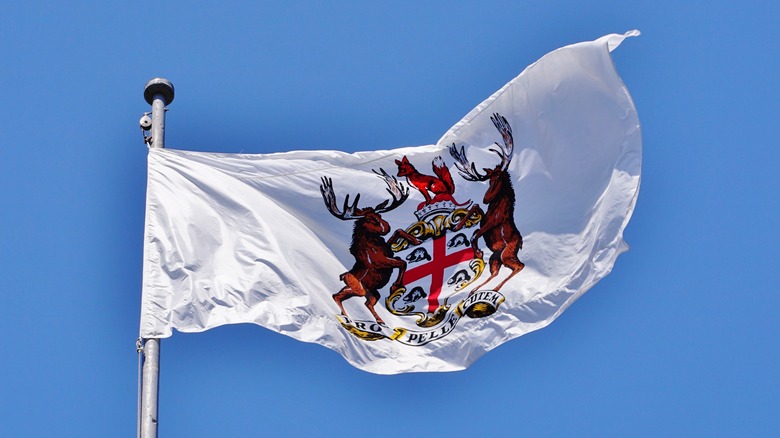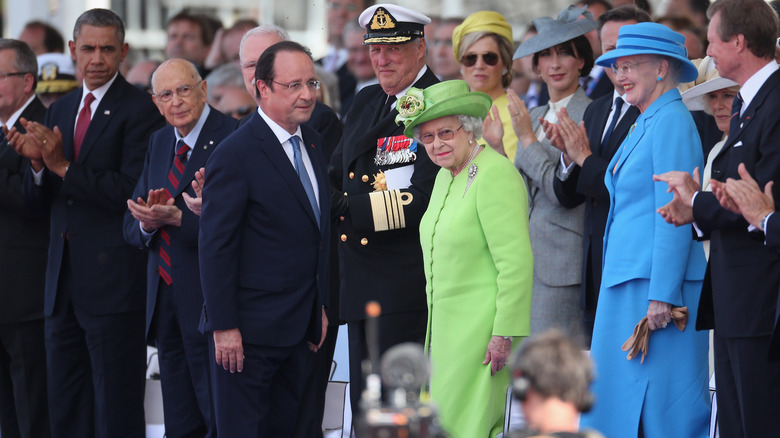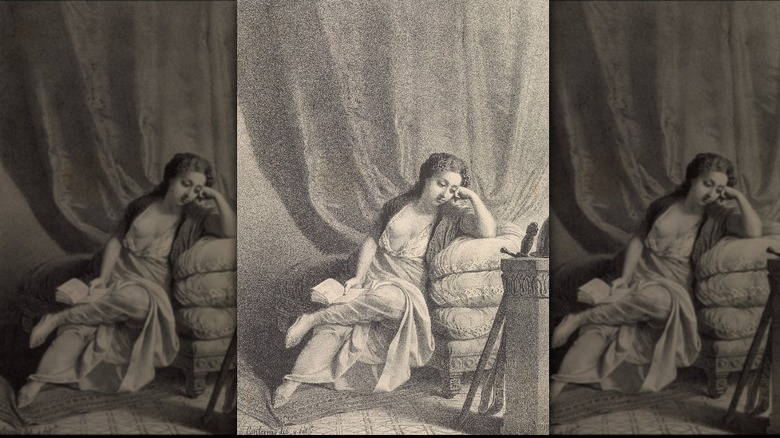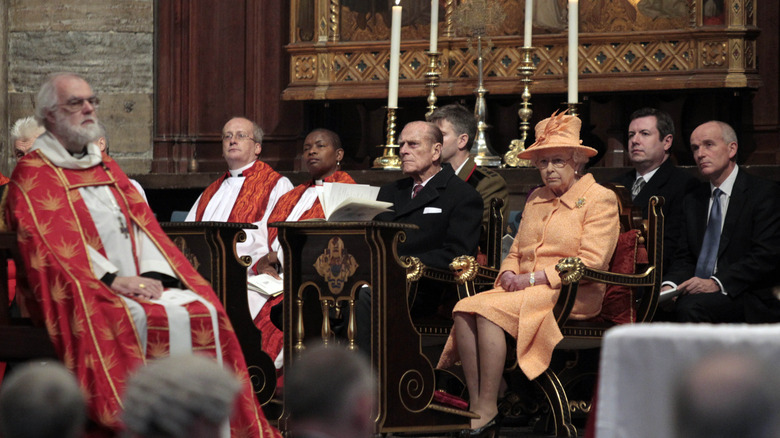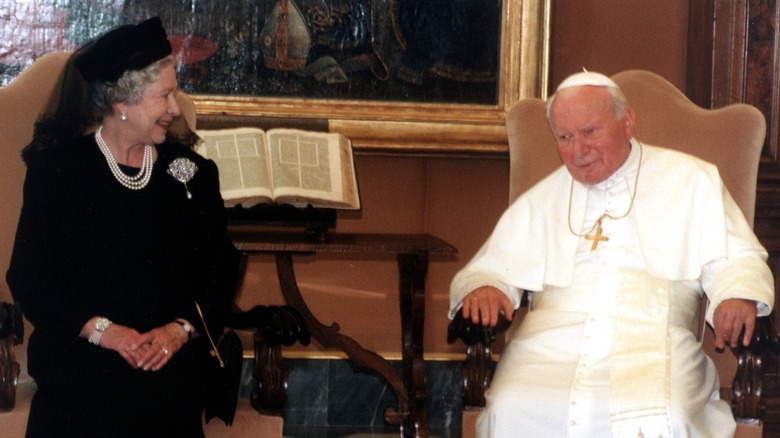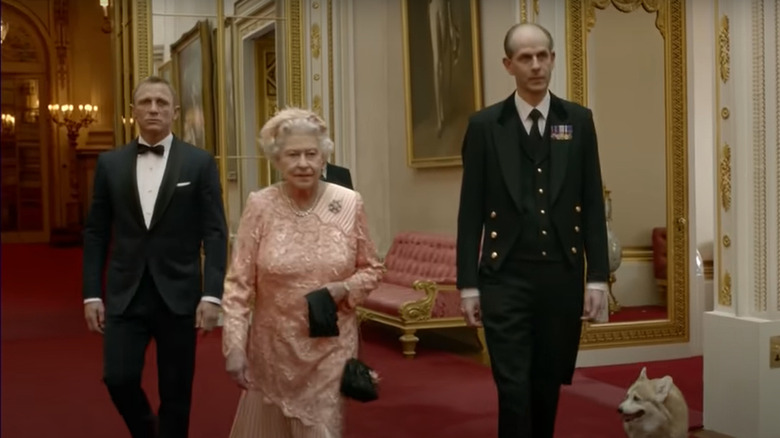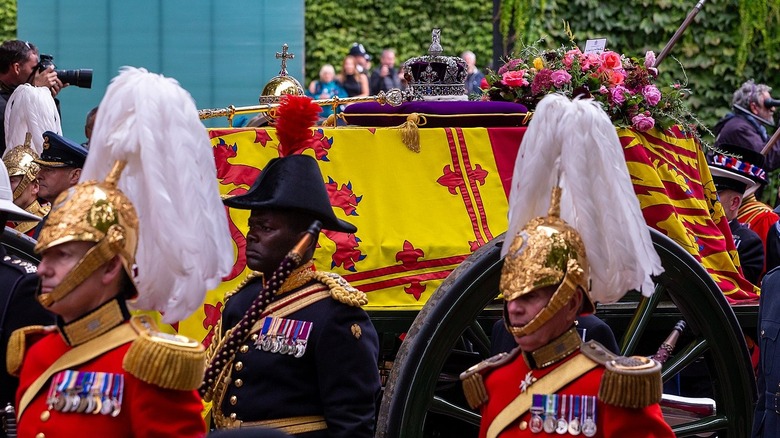The Untold Truth Of Queen Elizabeth II
Making it to 96 years old before she died on September 8, 2022, Queen Elizabeth II lived a long and interesting life. She met with numerous world leaders, many of whom have been dead for nearly a century. Although the queen frequently graced the gossip sections of the United Kingdom press, there was much more to her than what appeared in the tabloids. She played a crucial role in the governance of some of the United Kingdom's key institutions and was legally exempt from many rules that normal people have to follow. In this regard, she was incredibly powerful politically and financially. With such wealth, which was coupled with her position as head of the Church of England (via the royal website), she could probably have exercised far more direct power and influence than she did openly.
But fortunately, she also had a more intimate, human side. This is the untold truth of Queen Elizabeth II, the longest-reigning monarch (via Reuters) in British history.
Queen Elizabeth II worked as a mechanic during WWII
Queen Elizabeth's 1926 birth date put her in the right age bracket to serve in the Second World War. But as a woman and a royal, she did not have to. In fact, according to the U.K. newspaper The Standard, her father did not want her to. But he eventually caved, and she became the only female member of the royal family to be sent off the army. She enlisted in the Women's Territorial Auxiliary Corps, where she chose a surprising profession for her military service.
Truck driving is traditionally a blue-collar male profession. But this is exactly the profession Elizabeth was allowed to take up during the war. Her father refused to allow her to work in a factory, so instead, she was trained as a mechanic and truck driver. There are even photos showing that she learned how to disassemble, repair, and reassemble engines of different military vehicles. Her pride and joy? Getting her hands dirty. These were badges of honor for her to show off to her friends. While she was not to be treated any differently from her fellow servicewomen, she did have the perk of getting to sleep at home in Windsor Castle rather than in barracks. But for a family that has been branded as "parasites" in the Mirror and other sectors of the U.K. press, Queen Elizabeth was able to claim to have gotten her hands dirty, paid her dues, and gained some practical skills.
The U.K.'s biggest tax dodger?
As Town and Country Magazine notes, governments often try to squeeze every last cent from reluctant taxpayers. Even President Donald Trump faced IRS audits while in office. But British monarchs have a more complicated relationship with taxes. On paper, according to the Associated Press, they started paying income taxes in 1842. Today, those taxes are paid to HM Revenue and Customs Office, the U.K. equivalent of the IRS (pictured above). But a cozy relationship with Parliament allowed them to obtain exemptions, which Queen Elizabeth took full advantage of.
Queen Elizabeth's father George VI paid his taxes until around 1937, when he received an income tax exemption for the money he had to pay out to his brother, Edward VIII, in return for his abdication. According to The Guardian, however, Queen Elizabeth cut a deal with Prime Minister Winston Churchill to recoup dividend and interest taxes in addition to keeping her father's income tax exemption. According to Town and Country, Churchill's idea was originally well-conceived. He figured that if the queen was allowed to keep more of her income, she could use that to fund her activities rather than having the impoverished British taxpayer pick up the slack. But this break is also estimated to have netted the queen at least 1 billion pounds in profits.
In the early 1990's, Elizabeth announced that she would pay income taxes to placate anti-monarchist sentiment. But she was scrutinized again after the 2017 Paradise Papers revealed investments in offshore tax havens (via The Guardian). Despite the relatively small amount, the opacity of the royal finances (via The Guardian) continues to create suspicions of illicit activities by the crown estate.
She was literally above the law
During the 2016 presidential campaign, candidate Donald Trump joked about shooting someone in the middle of Fifth Avenue without losing voters. Such an act would have landed him in prison. But Queen Elizabeth could have theoretically gotten away with such a crime because, according to British Heritage, she was above the law.
The monarch enjoys protection from all prosecution under the principle of sovereign immunity. According to Cornell University's Legal Information Institute, this principle of British common law surmises that the state — or monarch — can do no legal wrong and can only be prosecuted for its crimes by its own consent. Queen Elizabeth was the U.K.'s head of state and the courts and law all operated in her name. Police officers in the U.K. do swear to uphold the monarch's rule, just as police officers in America swear to uphold the Constitution. Thus, it is easy to see why she could not be arrested, interviewed, or prosecuted. Although she did not pass laws, from a legal standpoint, she was the law.
Queen Elizabeth would have had to waive her sovereign immunity if she were to ever have been charged in one of her courts. Otherwise, she would have been prosecuting herself, since in Britain, the monarch, as head of the justice system, is always the plaintiff. Fortunately, this provision only applied to her — not to her family members — which made it legally possible to investigate and prosecute royals that have been accused of heinous crimes, such as those committed by Prince Andrew (via Town and Country).
She did not need a license to drive or a passport to travel
As queen, Elizabeth had an army of staff to chauffeur her around. But occasionally, as Town and Country Magazine notes, she liked to drive herself like an ordinary citizen. But unlike the average Briton, the queen was the only person who can drive without a drivers' license, driving lessons, or plate registration.
The exemption is a matter of royal prerogative. According to History, U.K. driver's licenses are issued in the monarch's name, and she could have issued herself one. But under her "discretionary powers" (via Fox), she was exempt from these rules. Fortunately, she had learned to drive a truck during the war, which requires a bit more skill than driving a car. So despite her lack of a license, she was able to be relied on to drive safely. According to Hello Magazine, even as an old lady, she enjoyed all-terrain vehicles such as Range Rovers, and she once scared King Abdullah of Saudi Arabia with what he deemed as reckless driving.
As with driver's licenses, she didn't need a passport either. According to the royal website, passports are also issued in the monarch's name and on their authority. Thus, it would have been redundant to issue herself one. As with sovereign immunity, these privileges didn't apply to her relatives.
She met every president since 1951 (except for Lyndon Johnson)
Since taking the throne in 1952, Elizabeth maintained relations with Britain's former colony, the United States. According to Business Insider, as head of state, it was her job to facilitate "the special relationship" between the U.S. and U.K. Thus, she met almost every U.S. president since Harry Truman.
According to BBC America, Queen Elizabeth got along swimmingly with President Dwight Eisenhower, who she met as a princess during his London sojourn as supreme allied commander. They even exchanged recipes. The relationship with the Kennedy administration was more complicated. According to Biography, the queen was suspicious of President John F. Kennedy due to his father's anti-British attitudes during his 1930s ambassadorship in London. First lady Jackie Kennedy did not help. According to the Washington Post, during a 1961 visit to the U.K., Jackie stole the British public's adoration and got into a spat over her Polish relatives being left off a royal dinner guest list. Jackie also criticized Buckingham Palace's furnishings, although it is unclear if Elizabeth ever became aware of them.
Only President Lyndon Johnson never met the queen in person. According to Newsweek, Elizabeth was pregnant at the time of Kennedy's assassination, so she did not attend the funeral where she could have met Johnson. Otherwise, although the two heads of state corresponded, they never invited each other to their respective homes. Why exactly is not known for certain.
Queen Elizabeth II owned 17% of the world's land
According to the royal website, the British Commonwealth consists of 54 mostly-former British colonies that cooperate economically, culturally, and diplomatically. Elizabeth was recognized as head of state in 16 of those countries, according to Sky News, while the other members of the Commonwealth recognized her as the organization's head. Her position in the Commonwealth gave her legal ownership of about 17% of the world's landmass.
According to the Australian magazine The New Statesman, there exist two major systems of land tenure in the world. One is the right to private property independent of the state, which the U.S. Constitution (via Cato Institute) enshrines. The other is based around the medieval idea of feudal land tenure, under which the monarch legally owned all land and could lease it out. Countries such as Australia, New Zealand, and many Caribbean countries fall under this latter system. Thus, Queen Elizabeth legally owned all the land in countries where she was recognized as head of state.
Unlike other monarchical states, Queen Elizabeth did not take part in land transactions personally. These are done by individuals, organizations, and various Commonwealth governments in the monarch's name. Thus, although the Kidman family of Australia (as in Nicole Kidman) are the largest landholders in the country, they legally leased their property from the queen.
She accepted The Hudson's Bay Company's rent in live beavers
The Hudson's Bay Company (HBC), according to the HBC Heritage Foundation, was chartered to procure pelts, which were plentiful in Canada's northern wilderness. But the charter was conditional. The HBC Heritage Foundation notes that the charter required the company pay "yearly to [the Crown] and our heirs and successors for the same two Elks and two Black beavers whensoever and as often as We, our heirs and successors shall happen to enter into the said Countries, Territories and Regions hereby granted."
In contemporary English, the charter stipulated that the HBC had to pay two elk and two beaver pelts for the right to trap and hunt if a royal ever visited the Hudson's Bay area. Although the HBC was chartered under Charles II in 1670, no monarch ever invoked the tribute until 1927, when Edward VIII visited as Prince of Wales. George VI followed in 1939, and Queen Elizabeth in 1959. When she visited Canada in 1970, she received live rent instead.
1970 was the 300th anniversary of the company charter. In celebration, the company gave Elizabeth two very frisky live beavers, who spent the entirety of the ceremony frolicking in their tank. When the queen asked what they were doing, the HBC governor simply told her, "it's no use asking me. I am a bachelor," suggesting that the beavers were not just playing. Despite a rainy day, the beavers stole the show and provided a delightful photographic memory. Today, the charter has been modified to remove the rent obligations.
She spoke French
European monarchs have generally been multilingual. Multilingualism was necessary for diplomacy, religion, and internal administration. According to the Yale Book of Quotations, Holy Roman Emperor Charles V boasted that he spoke Spanish to God, German to his horse, Italian to his mistress, and French to men. Russia Beyond notes that the Romanov tsars spoke German, English, and French among themselves. Russian was for servants. In this regard, Queen Elizabeth was the exception, as she only spoke one other language: French.
Officially, Elizabeth was fluent in French. But the English-language French paper The Local notes that the royal establishment refused to take questions on her language skills, which raised doubts. While the queen was able to give speeches in French with "excellent" pronunciation, she was reading these off a script. When talking in private conversations, the queen appeared to be able to hold her own. However, the footage is edited, and she resorted to English at least once, casting doubts on claims of fluency.
What is the truth? Queen Elizabeth learned French as a child. Her former governess Marion Crawford (via News 24) said that she hated it, dousing herself in ink in frustration at learning verbs. Thus, she was probably fluent as a child. But language needs to be used or it is lost. The queen did not regularly speak French, so it is possible she had lost fluency. Nevertheless, she still seemed to get by just fine.
She was related to Muhammad (allegedly)
European royalty are all related to each other. According to History Answers, frequent kin marriages led to closely-related families and genetic disease. European dynasties tended to marry with other European Christians. Rarely did the Islamic world manage to insert itself into Europe's nobility. But Queen Elizabeth might have been related to the Islamic prophet Muhammad thanks to an 11th-century Spanish relation.
This claim commonly references Burke's Peerage (via History), which in 1986 traced Elizabeth's ancestry to the Islamic prophet. This claim, although now absent from the site, has been repeated across the Muslim world. Its veracity rests upon Elizabeth's relation to an Andalusi princess named Zaida (pictured above) and her descent from Muhammad.
According to Al-Arabiya, Zaida, daughter of Abu al-Qasim Muhammad ibn Abbad of Seville became the concubine of Alfonso IV of Castille in the 11th century. Their descendants intermarried with English royalty in 1375. But it is unclear if Zaida was related to Muhammad at all. Her father supposedly descended from Muhammad through his daughter Fatima. But none of this is known for certain. As Nobles and Nation in Central Europe notes, family trees and bloodlines were manipulated or outright fabricated for political reasons. In Elizabeth's case, it seemed like an attempt to calm interfaith tension in an increasingly pluralistic U.K.
Queen Elizabeth II was the head of the Anglican Church
According to the BBC, King Henry VIII passed the Acts of Succession and Supremacy in 1534. The English monarch replaced the pope as head of the English Church and made England a Protestant country (via World History Encyclopedia). As a result, from 1952 to 2022, the Anglican Communion held the distinction of having a female head in Queen Elizabeth II, unlike Catholicism and Orthodoxy, which bar women from clerical leadership.
According to the royal website, the reigning monarch is the "Defender of the Faith and Supreme Governor of the Church of England," preserving Henry VIII's 1534 title. So it was for Queen Elizabeth II who, upon her coronation, swore to uphold the authority, doctrine, and structure of the church. In daily life, though, the queen delegated the everyday affairs and doctrines of the church or decisions to her bishops, chief among them Archbishop of Canterbury Justin Welby. But the queen also had one crucial power: the power to appoint bishops, who can influence the church's direction.
According to The Guardian, Anglican bishops are nominated by their parishioners, elected by the Crown Nominations Commission, and approved by the prime minister. Although the queen did not play a role in the selection process, according to Business Insider, she formally approved the appointments. Generally, however, she did not interfere with the selection of bishops and tended to rubber stamp appointments unless the prime minister advised her otherwise.
She nearly broke Vatican protocol
As both head of the Anglican Church and the U.K.'s head of state, Queen Elizabeth had the responsibility of meeting with the head of Anglicanism's old enemy, the Roman Catholic Church. Relations between Catholics and Anglicans have much improved since the days of Henry VIII, and the queen met with multiple popes since the 1950s (via ABC News). But one visit stands out — her private Vatican audience with Pope John Paul II in 2000.
When Queen Elizabeth visited the Vatican in 2000, her staffers argued about her outfit. According to the book "The Other Side of the Coin," written by the queen's former dresser Angela Kelly (via Evening Standard), her advisors urged her to wear a brightly colored outfit for her private meeting with Pope John Paul II. She agreed and they went to Rome.
There was a major problem, however. According to Italian newspaper La Stampa, all women must wear all-black, long-sleeved dresses that go below the knee and a head covering during private papal audiences. Only four people, the Catholic queens Sofia of Spain, Paola and Fabiola of Belgium, and Grand Duchess Maria Teresa of Luxembourg were exempt and could wear white. When the Vatican reminded the royal party of the dress code, Elizabeth panicked. She did not have a black outfit and there was no time to get one. But fortunately, Kelly, who had been raised Catholic, had snuck in two black dresses for the queen and averted a diplomatic embarrassment. The audience went ahead without a hitch.
She took part in a Bond cameo stunt in 2012
Royal life can seem tedious. Behind the glitz and glamor, there are the never-ending functions, charity events, and strict, mind-numbing protocols and courtesies that must be observed. Although Queen Elizabeth was touted as a stickler for propriety and "the rules" (via Vogue), she had had plenty of opportunities to showcase her fun-loving side. One of her most memorable moments saw her "jump" out of a helicopter.
Now, why would a then-86-year old lady agree to jump out of a helicopter? It was all part of the promotion of the 2012 London Olympic Games. As reported by ABC News, Queen Elizabeth II was escorted from Buckingham Palace by actor Daniel Craig, whom readers may recognize as the legendary agent James Bond. They then flew in a helicopter to the stadium, where both of them appeared to parachute into the stadium. While the queen participated in the scenes set in Buckingham Palace, she did not actually parachute. At that age, such a stunt would have probably killed or at least maimed her, so she had a stunt double.
Queen Elizabeth was quite enthusiastic about participating in the stunt, but she did so on one condition, revealing a more easygoing side of herself. She requested that she have a speaking role. Her choice? The classic phrase from the movies, "Good evening, Mr. Bond." Despite her stern appearance, no one can say she didn't have a sense of fun.
The Queen's final farewell was a global blockbuster
On September 8, 2022, Queen Elizabeth II's death at the age of 96 was announced several hours after it was reported her health had taken a serious downturn — and almost all senior members of the Royal Family had rushed to her side in Balmoral, per the BBC. The news made headlines around the world, but her funeral was to be the real showstopper.
The queen's coronation in 1953 was the first televised coronation of a British monarch in history, per The New York Times, and so it was too with her grand finale. Her funeral was a meticulously planned affair, surrounded by the largest security operation on British soil since WWII (via The Washington Post). For good reason, too: A global audience of over 4 billion people was expected to watch – over half of the population of the planet.
For those that wanted to pay their last respects to the queen in person, or for the numerous representatives of the almost 200 nations and territories that were invited, the event was even more daunting in scope on the ground. Per The Washington Post, so many heads of state arrived en masse that, to soothe a giant security headache, most were bussed into London, instead of the limousines they would typically expect. And the line to see Queen Elizabeth II as she laid in state, prior to the historic televised funeral, was a truly British queue — over 10 miles long at its greatest extent, per the BBC.
